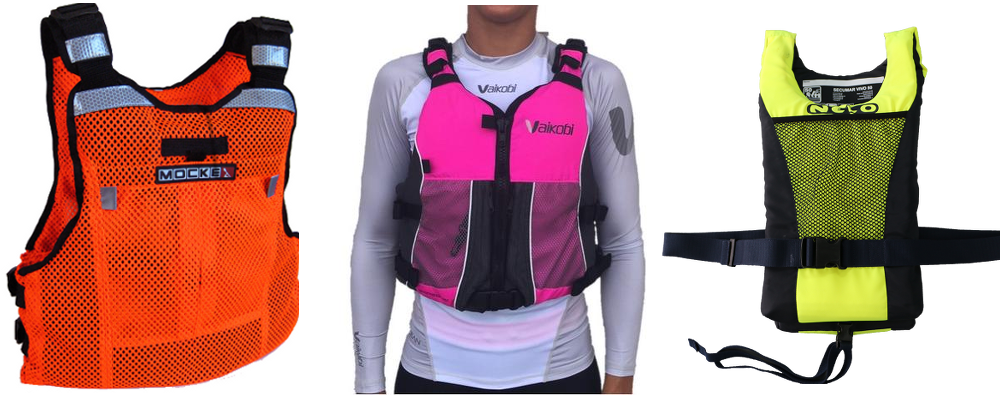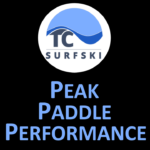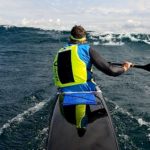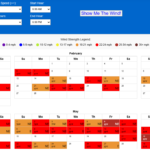Summarizing the Key Points about the PFDs We Sell
I recently posted a Facebook update to let everyone know I’m now carrying the Nelo branded personal flotation device (PFD). This post generated a lot of discussion around Newtons and ISO versus US Coast Guard certification. While I am far from an expert in this space, I thought it might be helpful if I outline the high level basics and my personal opinions.
First and foremost, the best PFD is the one you will wear each and every time you venture out onto the water!
At TC SURFSKI we currently sell three different PFDs, all of which I use on a regular basis and all of which shine in their own unique way.
None of the PFDs that we sell are officially US Coast Guard Approved. All of them are ISO 12402-5 Approved.
Understanding the PFD Categorization
Both ISO and the USCG recognize different forms of PFDs which serve different purposes. The bouyant foam PFDs that we sell are considered Type II, which is the category designed to be worn by active paddlers in situations where rescue is not likely to take more than 2 hours. These PFDs are not expected to absolutely float the individuals head well above water with no effort as a Type 1 would be, but they are intended to provide enough flotation assistance to keep the individual above water with minimal effort and/or to provide enough assistance to swim for shore.
Type III PFDs are inflatables that provide more flotation, but always present a possibility of mechanical failure
You can read more details on the USCG PFD requirements here, but the biggest difference between the ISO certified life jackets we sell and the USCG approved Type II is that the USCG requires 70 Newtons of flotation, whereas the Nelo and Vaikobi have 50 and the Mocke has 60 Newtons.
The USCG website readily admits there their guidelines aren’t perfect, it isn’t an exact science, and this whole space is constantly evolving. One area where Nelo, Mocke, and Vaikobi are all ahead of the curve is in visibility. Their PFDs are all extremely visible and in my opinion this ultimately makes them much, much safer than a PFD with 20 more newtons of flotation that is blue, black, or brown and can’t easily be seen on the water.
Choosing the Right Fit
The Nelo (one size fits all) and Vaikobi both have 50 Newtons of flotation, regardless of the size. The Mocke has 60 newtons of flotation across all sizes. It is important to note that there is no specific ratio of body weight to newtons of flotation. Flotation requirements can very significantly between two people and are based on body fat percentage, lung capacity, clothing being worn, and wave conditions. Individuals with lower body fat percentage will require more flotation than those with higher body fat.
All of the PFDs have a fairly wide fit range. Some paddlers like to go on the smaller range and stretch the straps out all the way, and others like them with room to spare so they fit well over wetsuits and drysuits. Chest size is the key measurement, but if you’ve imbibed on a few too many micro brews lately, consider sizing up. I’ve had several customers lately order the Mocke M/L and discover they actually needed the XL.
Will you get in trouble for not having a USCG approved PFD?
I get this question a lot. I have certainly heard stories from others where harassment has occurred, but I believe in 99% of cases, officials are more than happy to see participants wearing some form of PFD and they aren’t too concerned with whether or not it has a USCG stamp of approval. Clearly the ones offered by Mocke, Vaikobi, and Nelo are quality PFDs proven to do the job they are intended to perform.
My favorite attributes of each of the Brands
Mocke Ocean Racer
- The large front pocket of this PFD is second to none. When you need to carry a big safety kit (cell phone, VHF, flares, beanie, whistle, Spot Gen 3, bluetooth speaker) up front where it is easily accessible this is a massive benefit
- No zipper design – probably more of a benefit for those paddling salt water, but as long as your shoulder mobility is good (which it should be) this simplifies the PFD adding one less thing to hassle with
Vaikobi High Vis PFD
- The most stylish PFD ever made (and the new hot pink takes it to a whole new level)
- The high vis yellow can be seen for miles. I don’t have facts, but I’m convinced it is the highest visibility PFD ever produced
Nelo PFD
- Super, super lightweight and unrestrictive, the ultimate minimalist PFD
- The between the legs strap is simple, but immensely effective, allowing you to wear the PFD loose, but not have to worry about it riding up to your chin when you’re in the water and trying to remount your surfski
Both the Mocke and Vaikobi offer large rear bladder pockets. I don’t think many serious paddlers store hydration in their PFD anymore as it adds weight up top that can have an impact on stability and isn’t that comfortable. However, the rear pocket can be a great place to throw your cell phone connected to a lanyard. The reason for this, is that the cell phone can easily get pinched on remount when it is in a chest pocket. The rear pocket is also a great place for extra supplies such as a beanie cap.
I tend to find myself wearing the following:
- Mocke during the colder months when I carry a large safety kit
- Vaikobi during the summer when I need to look good and carry just a few supplies
- Nelo on the hottest days and when I’m racing and want the ultimate in lightweight and don’t need to carry much
I hope this helps in your decision to find the right PFD. Don’t hesitate to contact me with any questions




